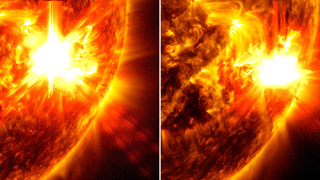Largest Flare yet from Solar Cycle 25
On May 14, 2024, the Sun emitted a strong solar flare. This solar flare is the largest of Solar Cycle 25 and is classified as an X8.7 flare. X-class denotes the most intense flares, while the number provides more information about its strength.
A solar flare is an intense burst of radiation, or light, on the Sun. Flares are our solar system’s most powerful explosive events. Light only takes about 8 minutes to travel from the Sun to Earth, so that’s how long it would take the energy from a flare to reach our planet. Stronger solar flares — those rated class M5 or above — can have impacts on technology that depends on Earth’s ionosphere (our electrically charged upper atmosphere), like high-frequency radio used for navigation and GPS.
NASA’s Solar Dynamics Observatory (SDO) captured these images of the flare, which peaked at 12:51 p.m. ET on May 14. The X8.7 flare appears on the lower right edge of the Sun. (A small eruption appears afterward in the upper left.) SDO sees the Sun in more than 10 distinct wavelengths of light, showing solar material at different temperatures. Different wavelengths are shown in this video to highlight different features of the flare.
Music credit: “Ethereal Mirrorscape” from the album Reflections written and produced by Lars Leonhard
Watch this video on the NASA Goddard YouTube channel.
Complete transcript available.

NASA’s Solar Dynamics Observatory captured this image of a solar flare – as seen in the bright flash on the right – on May 14, 2024. The image shows a subset of extreme ultraviolet light that highlights the extremely hot material in flares and which is colorized in red and yellow. Credit: NASA/SDO

NASA’s Solar Dynamics Observatory captured this image of a solar flare – as seen in the bright flash on the right – on May 14, 2024. The image shows a subset of extreme ultraviolet light that highlights the extremely hot material in flares and which is colorized in red and yellow. Credit: NASA/SDO

NASA’s Solar Dynamics Observatory captured this image of a solar flare – as seen in the bright flash on the right – on May 14, 2024. The image shows a subset of extreme ultraviolet light that highlights the extremely hot material in flares and which is colorized in red and yellow. Credit: NASA/SDO

NASA’s Solar Dynamics Observatory captured this image of a solar flare – as seen in the bright flash on the right – on May 14, 2024. The image shows a subset of extreme ultraviolet light that highlights the extremely hot material in flares and which is colorized in red and yellow. Credit: NASA/SDO

NASA’s Solar Dynamics Observatory captured this image of a solar flare – as seen in the bright flash on the right – on May 14, 2024. The image shows 304 angstrom light. Credit: NASA/SDO

NASA’s Solar Dynamics Observatory captured this image of a solar flare – as seen in the bright flash on the right – on May 14, 2024. The image shows 171 angstrom light. Credit: NASA/SDO

NASA’s Solar Dynamics Observatory captured this image of a solar flare – as seen in the bright flash on the right – on May 14, 2024. The image shows 193 angstrom light. Credit: NASA/SDO

NASA’s Solar Dynamics Observatory captured this image of a solar flare – as seen in the bright flash on the right – on May 14, 2024. The image shows 131 angstrom light. Credit: NASA/SDO

NASA’s Solar Dynamics Observatory captured this image of a solar flare – as seen in the bright flash on the right – on May 14, 2024. The image shows 131 angstrom light. Credit: NASA/SDO
NASA’s Solar Dynamics Observatory captured this imagery of a solar flare – as seen in the bright flash on the right – on May 14, 2024. This group contains 4k frames and video covering three hours from 15:00 to 18:00 UTC. Credit: NASA/SDO
NASA’s Solar Dynamics Observatory captured this imagery of a solar flare – as seen in the bright flash on the right – on May 14, 2024. This group contains 4k frames and video covering three hours from 15:00 to 18:00 UTC. Credit: NASA/SDO
NASA’s Solar Dynamics Observatory captured this imagery of a solar flare – as seen in the bright flash on the right – on May 14, 2024. This group contains 4k frames and video covering three hours from 15:00 to 18:00 UTC. Credit: NASA/SDO
NASA’s Solar Dynamics Observatory captured this imagery of a solar flare – as seen in the bright flash on the right – on May 14, 2024. This group contains 4k frames and video covering three hours from 15:00 to 18:00 UTC. Credit: NASA/SDO
NASA’s Solar Dynamics Observatory captured this imagery of a solar flare – as seen in the bright flash on the right – on May 14, 2024. This group contains 4k frames and video covering three hours from 15:00 to 18:00 UTC. Credit: NASA/SDO
For More Information
Credits
Please give credit for this item to:
NASA's Goddard Space Flight Center. However, individual items should be credited as indicated above.
-
Producer
- Scott Wiessinger (eMITS)
-
Writer
- Abbey A. Interrante (ADNET Systems, Inc.)
-
Visualizer
- Tom Bridgman (Global Science and Technology, Inc.)
Release date
This page was originally published on Tuesday, May 14, 2024.
This page was last updated on Sunday, March 9, 2025 at 11:18 PM EDT.
![16:9 Landscape Version with HBY Logo and NASA MeatballMusic Credit: “Society News Bed Instrumental” by Jean-Francois Berger [SACEM] via Universal Production Music](/vis/a010000/a014600/a014685/thumbnail_design.png)


